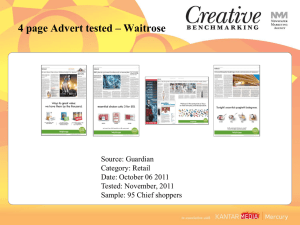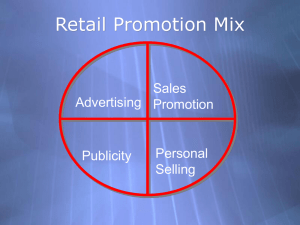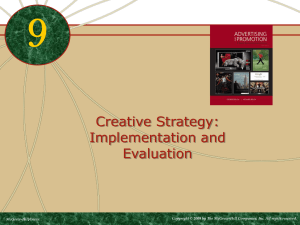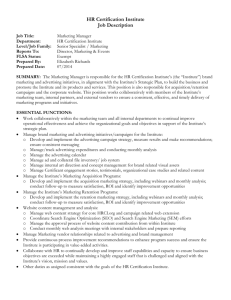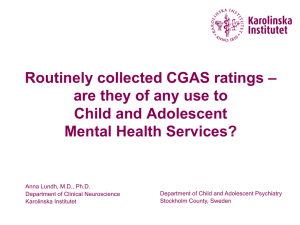Special Session Consumer-Generated Advertising: Creators and
advertisement
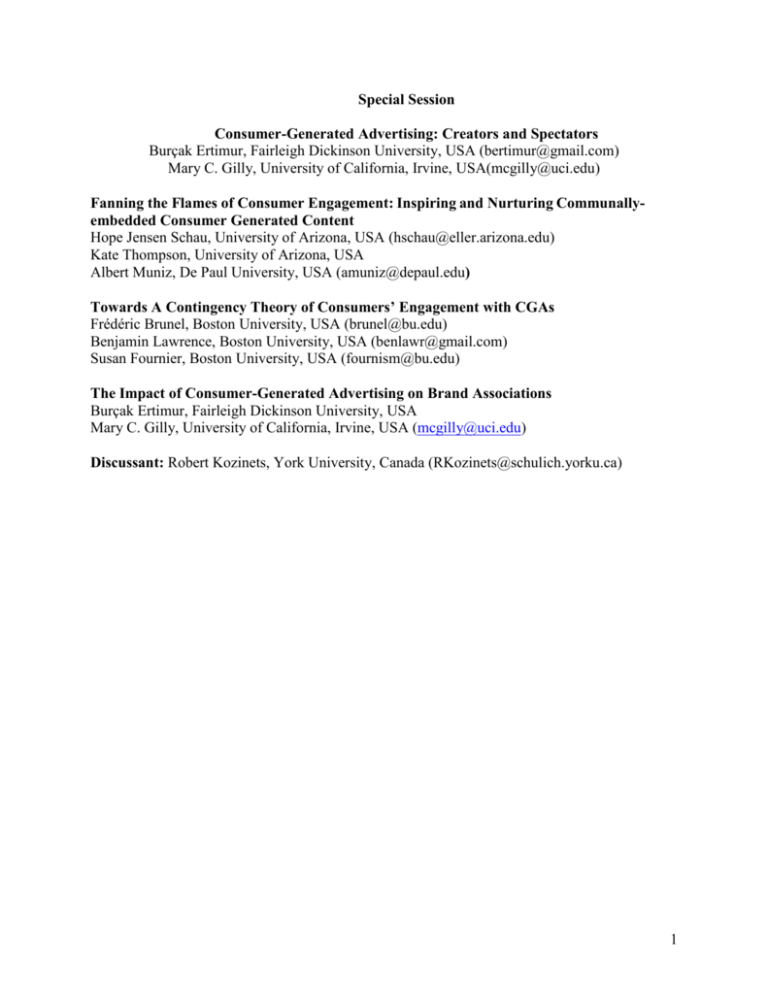
Special Session Consumer-Generated Advertising: Creators and Spectators Burçak Ertimur, Fairleigh Dickinson University, USA (bertimur@gmail.com) Mary C. Gilly, University of California, Irvine, USA(mcgilly@uci.edu) Fanning the Flames of Consumer Engagement: Inspiring and Nurturing Communallyembedded Consumer Generated Content Hope Jensen Schau, University of Arizona, USA (hschau@eller.arizona.edu) Kate Thompson, University of Arizona, USA Albert Muniz, De Paul University, USA (amuniz@depaul.edu) Towards A Contingency Theory of Consumers’ Engagement with CGAs Frédéric Brunel, Boston University, USA (brunel@bu.edu) Benjamin Lawrence, Boston University, USA (benlawr@gmail.com) Susan Fournier, Boston University, USA (fournism@bu.edu) The Impact of Consumer-Generated Advertising on Brand Associations Burçak Ertimur, Fairleigh Dickinson University, USA Mary C. Gilly, University of California, Irvine, USA (mcgilly@uci.edu) Discussant: Robert Kozinets, York University, Canada (RKozinets@schulich.yorku.ca) 1 Consumer-Generated Advertising: Creators and Spectators Burçak Ertimur (Fairleigh Dickinson University) and Mary C. Gilly (University of California, Irvine) The emergence of consumer-generated advertising (CGA) has greatly affected the advertising landscape by eroding the separation between the producer and the consumer and challenging the traditional view of advertising as non-personal, unidirectional, and paid-for communication (Berthon, Pitt, Campbell 2008). Many companies jumped on the CGA bandwagon; however, the results have been inconsistent (Petrecca 2007), leaving the question of whether the hype of CGA can live up to the standards of traditional advertising unanswered. There has been very limited research on the new concerns brought up by CGA, hindering our understanding of consumers’ capabilities in crafting CGAs as well as their perceptions and interpretations of these new types of ads. This symposium explores the phenomenon of CGA from the perspective of both the creators and the spectators through the presentation of three completed empirical studies. The objective of this session is to provide a better understanding of CGA’s effectiveness, specifically in terms of its content and communication value, and to stimulate further research exploring the realm of CGA. The first paper by Schau, Thompson, and Muniz focuses on the creators of CGAs, and examines the collaborative and prolonged process through which the Twilight brand community members collectively create, disseminate, and distill content. Research by Brunel, Lawrence and Fournier shift the focus towards consumers’ reactions to CGA. Based on a lab experiment and a phenomenological inquiry, the authors discuss the potential of CGAs in facilitating consumer engagement and provide insights into the key facets of engagement, the underlying processes, and the conditions under which different patterns of engagement may emerge. In the third paper, Ertimur and Gilly augment our understanding of consumers’ reactions to CGA by scrutinizing the communication value CGAs as evidenced in consumers’ evaluations of credibility. Using netnographic and interview data, the authors assess the appeal of CGAs vis-à-vis traditional advertising and highlight the impact of consumers’ evaluations on brand associations. Following the presentations, our discussant, Robert Kozinets, offers his insights and comments on the three studies and closes the session with suggestions for future research directions. We hope that these three presentations along with our discussant’s integrative comments provide the grounds for building theory regarding this new phenomenon and offer novel insights for consumer researchers interested in advertising theory and practice. Extended Abstracts Fanning the Flames of Consumer Engagement: Inspiring and Nurturing Communallyembedded Consumer Generated Content Hope Jensen Schau (University of Arizona), Kate Thompson (University of Arizona) and Albert Muniz (De Paul University) Many studies have demonstrated that members of brand communities are capable of extensive creation of brand content (Brown, Kozinets and Sherry 2003; Muniz and Schau 2007; Schau and Muniz 2006; Schau, Muniz and Arnould 2009). Indeed, the ascendancy of communally-embedded, empowered consumers is now a marketplace reality (Flight 2005; Ives 2004; Morrissey 2005). Such customer evangelism goes by many names, including “homebrew ads” (Kahney 2004), “folk ads” (O’Guinn 2003), “open source” branding (Garfield 2005) and 1 “vigilante marketing” (Ives 2004; Muniz and Schau 2007). While several marketers have begun to actively solicit Consumer Generated Content (CGC) for occasional, ad hoc use in advertising campaigns (e.g. Doritos Super Bowl 2009), little if any research has addressed collaborative CGC, nor the role of the firm in encouraging prolonged CGC endeavors that require relinquishing considerable control of the brand meaning and messages. Moreover, the research on CGC thus far has focused primarily on male consumers with advanced technical skills who work independently or with a discrete set of known partners on a single CGC project for which they most often get explicit credit and even monetary rewards. Currently missing are studies that examine prolonged collaborative CGC among relatively unknown partners where the creative impetus lies in complex and nuanced narrative and character analysis, rather than technological mastery. Stephenie Meyer, author of the Twilight saga, inspires passion and devotion in individual readers, but importantly she also incites and nurtures widespread collective engagement with the brand in the form of a brand community demonstrating the markers identified in Muñiz and O’Guinn (2001): consciousness of kind, rites and rituals, and moral responsibility. Twilight fans read the books and discuss them in online and offline book clubs and events. Often these fans are brought together by their mutual interest in, and admiration for, the brand and little else (scant contact beyond brand-based experiences). Yet, Twilight fans collectively create CGC and influence brand production. Our data consist of: the Twilight saga (including an unauthorized draft novel), a feature film, literary and film criticism of the Twilight media products, naturalistic and participant observation in three online fan forums and two offline events, collectively created CGC (videos, images and texts), as well as, email and face-to-face interviews with brand fans inside and outside the brand community and CGC creators. Our data were iteratively collected and thematically coded and recoded following the hermeneutic tradition. Like American Girl (Diamond, Sherry, Muniz, McGrath, Kozinets and Borghini, 2009), we find the Twilight brand community members are primarily female (currently underrepresented in brand community research), and generally range from 12-65. The older women in the brand community are often the mothers of daughters who were first Twilight fans and “turned them on” to the books. We find that the community contains factions based on age, life stage, character affiliation, plot interpretations, and broad ideological identification. Through the Twilight brand community we demonstrate the strategic use of open text branding to invite collective action, the deliberate encouragement of vigilante marketing to promote the brand, and the interplay of contrived heterogeneity within the brand community as an impetus for prolonged brand community engagement and collaborative CGC. We find at the center of the phenomenon is the perpetual melodrama emanating from an inability to achieve closure and a desire to close narrative loops. These vampires are immortal, but suspended in adolescence, perpetually coming of age; this means their conflicts cannot be entirely resolved. Fans universally find the vampires and werewolves sympathetic and their efforts to exist without harming humans to be noble. The vampire quest for legitimacy and acceptance and the werewolf desire to peacefully co-exist within human society is intriguing and fan discourse compares these to race, ethnicity and class struggles in contemporary society. Collaboratively created CGC employs direct references to larger macro-social plights such as the Civil Rights Movement in the US and abroad, US and global feminist issues and peace activists in their CGC. These macro issues play out against the backdrop of a popular melodramatic media brand with full-approval of the producer. Twilight is a platform for fans to engage in these larger social issues; for many 2 Twilight is the first impetus to consider these topics and the first time that these people have engaged in collective debate of the issues. Our data demonstrate effective CGC that is collectively created, disseminated and distilled within a strong consumer controlled and producer nurtured brand community. The Twilight collectively created CGC is predominately antithetical to previous studies where CGC is assumed to be inspired by personal brand attachment and/or the desire to see discrete-authored CGC disseminated, or even motivated by monetary reward. Authorship of collaboratively produced CGC is virtually untraceable, unknown and monetarily uncompensated (much like Wikipedia). The true reward is the process and the outcome is not reliant on technical prowess but rather semiotic manipulation, narrative manipulation and complex character development. Like previous studies (Muniz and Schau 2007), we find consumers quite adept at appropriating and mimicking the styles, tropes, logic and grammar of advertising and film trailers. More significantly, Twilight consumers demonstrate mastery of intertextuality (O’Donohoe 1997) by utilizing the permeable boundaries between marketing communications and other socio-cultural texts via appropriation. They demonstrate mastery of polysemy (Kates and Goh 2003; Ritson and Elliott 1999), creating artifacts with different meanings for different groups. Towards A Contingency Theory of Consumers’ Engagement with CGAs Frédéric Brunel (Boston University), Benjamin Lawrence (Boston University), and Susan Fournier (Boston University) With the proliferation of personal digital media technology, today’s consumers have the toolbox to cheaply and quickly produce, distribute and engage in sophisticated marketing content (Muñiz and Schau 2007). Though past studies have looked at the effects of interactive versus traditional advertising (Bezjian-Avery, Calder, and Iacobucci 1998), there has been limited research (Berthon, Pitt, and Campbell 2008; Muñiz and Schau 2007) on CGAs. CGA needs to be better understood with respect to its effectiveness relative to traditional advertising and to the processes that consumers use to interpret and react to these new ads. Many companies such as Jones Soda have embraced consumer co-creation and CGA as part of their core marketing strategies while others have confined it to specific promotions or competitions (e.g., Frito-Lay, Unilever, Chevrolet, and Heinz). Yet, one thing appears common to all who include CGA in their communication strategies: a belief that CGA engages consumers more deeply with the brand. Consumer engagement is a central preoccupation in the advertising community, with industry groups such as the Advertising Research Council, the Association of National Advertisers, and the American Association of Advertising Agencies creating specific Engagement Councils “to provide an industry-leading peer discussion forum, for the continuous refinement and application of the Engagement construct” (thearf.org). One ultimate question remains: does CGA actually facilitate consumer engagement? More specifically, do CGAs engage consumers in the same way as traditional company-generated ads? If not, how are they different? What are the key drivers of CGA effectiveness? We designed a multi-method program of study to answer these questions. First, in a lab experiment, we compared advertising responses when the same advertisements were either identified as having been created by consumers or no source information was provided. This study explored whether CGAs present communication advantages and investigates processing factors that drive CGA responses. We chose Toyota Yaris as the focal brand for this study for two reasons: 1) it is targeted to a young driver audience similar to our pool of student 3 respondents, and 2) consumers have created ads for this brand. Four judges selected four (out of thirty) 30-second Yaris CGAs with varying levels along two dimensions known to affect advertising response: execution quality and product information content (Mitchell 1986). Based on a random assignment, 196 student respondents were assigned to view one of the ads, and were instructed either that the ad had been created by a consumer or were not told anything about the creator. Confirming our hypothesis there was a significant main effect of ad creator source on various ad response measures. Respondents who were told the ad was a CGA reported higher attitudes toward the ad (p<.05) and higher evaluations of the executional quality (p<.05). They also reported that the ad was more engaging (p<.05) and they were more likely to seek information about the Yaris brand and consider the Yaris as a potential future car (also p<.05). Further, additional path analyses suggested the advertising response pattern in the CGA condition was akin to a high involvement/central processing response pattern, whereas the response pattern in the no-source condition was consistent with low involvement processing. These results confirm that consumers appear to react more favorably to CGAs and CGAs can increase engagement. Our second study was a phenomenological inquiry of responses to CGA in a natural viewing environment that provides a holistic understanding of consumers’ engagement with different types of CGAs. We content analyzed responses (i.e., verbatim transcripts of 671 YouTube posts) to eight CGAs: six contest-driven CGAs (Dove, Doritos, and Chevy HRR) and two organically-created CGAs (Firefox, and Wii). Focal ads spanned multiple product categories, brands, and advertising strategies (i.e., product information, humor, consumer values). Our findings provide both support for –and challenge of—the contention that CGAs present systematic advantages in terms of consumer engagement. All Dove CGA ads, as well as the Wii and Firefox CGA ads, exhibited high levels of consumer engagement, as defined in terms of personal involvement, cognitive elaboration, and ad elaboration. However, two additional and dominant facets of engagement were uncovered. For the Dove ads, engagement centered on community- and relationship-building dialogues. In particular, the comments evidenced protracted viewer-viewer and viewer-creator conversations involving the ads and the brand, and professed support for and interdependency between viewers. On the other hand, engagement for the Firefox and Wii ads involved brand evangelism, brand advocacy, and the characteristic in-group/out-group brand debates defining community brands. Postings originated from focal brand supporters and also from opposing brand loyalists, spurring heated emotional debate and confrontations. Inducting from our findings, one key difference driving these engagement patterns is the participation and involvement (or absence) of the oppositional community group (i.e., Microsoft Xbox and Sony PS2 against Wii, and Internet Explorer versus Firefox): a key tenet defining community status for a brand (per Muniz and O’Guinn 2001). Interestingly, two of the CGAs under study—Chevy HHR and Doritos—did not evidence any of the engagement facets uncovered above. Responses for these ads concerned entertainment value and not much more. In this sense, the humor advertising strategies used in these ads swamped any potential deeper engagement. Based on our findings it seems that depending on the ad strategy, CGA ads may in fact provide no observable engagement benefit. In summary, across the two studies we found evidence that CGA can influence viewer’s engagement and ad response, yet there does not appear to be a “wholesale” CGA effect. CGA effects are complex and must be viewed in the context of the brand type and the ad strategy in 4 which they are embedded. In our lab study, limited to one brand and one product category, we were able to show that CGA can improve consumer reactions and engagement with the ad and brand. However, in a natural environment, different patterns of consumer engagement with CGAs emerged and were manifest only under specific conditions. Together our findings provide the foundation for a contingency-based understanding of the effects of CGA, though a complete contingency theory is yet to be defined. The Impact of Consumer-Generated Advertising on Brand Associations Burçak Ertimur (Fairleigh Dickinson University) and Mary C. Gilly (University of California, Irvine) A common way for organizations to evoke favorable associations is through advertising (Dowling 2001). Yet the effectiveness of such efforts is often questionable because consumers tend to be skeptical about advertising messages and distrust the media as well as corporate advertising (Elliott, Eccles, and Hodgson 1993; Mohr, Webb, and Harris 2001). With the emergence of consumer-generated advertising (CGA), however, advertising is no longer a company-controlled form of communication. CGA also provides a direct avenue for consumers to participate in creating brand images. An emerging stream of research examines what drives consumers to generate ads and whether they are successful in their advertising creation endeavors (e.g., Muniz and Schau 2007). CGAs also reach other current and potential customers of the companies featured in CGA (McConnell and Huba 2007). Little is known, however, about such consumers’ perceptions and reactions towards CGA. In this study, we examine consumers’ reactions towards two types of CGAs. The first type is solicited CGA, initiated by companies designing contests and inviting consumers to create ads for their products (e.g., Doritos). The second type is unsolicited CGA, meaning that consumers create an ad on their own without any support from the company (e.g., George Masters’ ad for Apple iPod). To assess how different types of CGAs contribute to brand associations, we study consumers’ responses to and interpretations of CGAs vis-à-vis traditional ads. We also seek to understand communication value of CGAs, and specifically, how consumers evaluate them in terms of credibility. On the one hand, both types of CGAs may be seen as similar to conventional ads in that they are intended to be persuasive and they look as well as feel like ads. On the other hand, CGAs may be viewed as word-of mouth (WOM) communications given that they are created by consumers, not marketers, and are not commercially motivated. Subsequently, CGAs may provide benefits such as increased credibility in comparison to traditional ads as is the case in WOM communications. To address these issues, we investigate and compare consumer responses to both types of CGAs as well as a company ad in contexts where the ad source is known versus unknown. We gathered three different types of ads that feature an instant stain remover produced by Procter and Gamble (P&G) called Tide-to-Go. P&G ran a Tide-to-Go ad during the Super Bowl in 2008 and followed it up with a CGA contest that asked consumers to create their own version of this ad. In addition to the solicited CGAs and the company ad, there were already CGA for Tide-toGo that were uploaded on YouTube prior to P&G’s announcement of their contest. We use a combination of in-depth interviews (McCracken 1988) and netnography (Kozinets 2002) to collect data from consumers and consumer sites online. We conducted fourteen interviews with target consumers of Tide-to-Go to understand how consumers make sense of the different types of Tide-To-Go ads. The netnographic data consist of consumer comments generated in response to the three types as they appeared on YouTube and the company website as well as company 5 and brand mentions online. While consumers in the face-to-face interviews did not know the source of the ads, the online commentators in the netnographic study knew them. The netnographic data on the company and brand mentions create the background against which consumers’ responses to the ads are analyzed. Data collection and analysis followed an iterative process (Spiggle 1994) and the analytic techniques offered by Strauss and Corbin (1998) were used to arrive at themes. The analysis of online comments shows that consumers recognize CGAs as ads and they understand the underlying effort to sell. However, in contrast to previous work on consumer skepticism toward advertising (e.g., Scott 1994), consumers do not resist being influenced by these ads. Rather they adopt a marketer’s frame and critique these ads’ effectiveness. They do so by relying on their persuasion knowledge (Friestad and Wright 1994) at the expense of their brand knowledge. This is evident in their evaluations that draw largely on their beliefs about the role played by psychological events evoked by the ad and ad creators’ persuasion goals as well as their ideas about the effectiveness and appropriateness of marketers’ tactics in general. These responses lack thoughts and beliefs about the brand, accounts of prior experiences with the brand, and the brand message conveyed by the ad. Our face-to-face interviews also substantiate the idea that CGAs are perceived as persuasion attempts and reveal that consumers are capable of differentiating amongst the different types. Consumers recognize the dual source of CGAs, and interactions between the perceptions of these sources determine these ads’ credibility. In particular, they perceive the creator component of CGAs’ source as unfamiliar, which in turn, makes CGAs’ credibility doubtful. Consumers believe that anyone could have created these ads regardless of belonging to the target market or having any experience with the brand. They appreciate other consumers’ perspectives on Tide-to-Go conveyed though CGAs; nevertheless they question these creators’ expertise and authority. The findings further suggest that this detraction from the credibility of CGAs due to the unfamiliarity with the creator component of the source may somewhat be compensated through knowledge about the sponsor and/or the brand. In conclusion, we find that consumers evaluate CGAs in their own right, independent of the product they feature, by drawing on their persuasion knowledge as a resource. Although the development of persuasion knowledge is historically contingent (Friestad and Wright 1994), consumers use their existing persuasion knowledge about company ads to make sense of these new forms of ads (i.e., solicited and unsolicited CGAs). Our study also demonstrates that CGAs cannot be merely viewed as word of mouth communications and stresses the complexity of consumers’ perceptions of CGA. This new hybrid persuasion device, CGA, is viewed as neither company propaganda nor simple consumer recommendations. Our findings contribute to building theory regarding source credibility in this new medium. References Berthon, Pierre, Leyland Pitt, and Colin Campbell (2008), "Ad Lib: When Customers Create the Ad," California Management Review, 50 (4), 6-30. Bezjian-Avery, A., B. Calder, and D. Iacobucci (1998), "New Media Interactive Advertising Vs. Traditional Advertising," Journal of Advertising Research, 38, 23-32. Brown, Stephen, Robert V. Kozinets and John F. Sherry, Jr. (2003), “Teaching Old Brands New Tricks: Retro Branding and the Revival of Brand Meaning,” Journal of Marketing, 67 (July), 19-33. 6 Diamond, Nina, John F. Sherry Jr., Albert M. Muniz, Jr., Mary Ann McGrath, Robert V. Kozinets, and Stefania Borghini (2009), “American Girl and the Brand Gestalt: Closing the Loop on Sociological Branding Research,” Journal of Marketing, 73 (May), 118-134. Dowling, G. R. (2001), Creating Corporate Reputations. New York: Oxford Universitiy Press. Elliott, Richard, Susan Eccles, and Michelle Hodgson (1993), “Re-Coding Gender Representations: Women, Cleaning Products, and Advertising’s “New Man”,” International Journal of Research in Marketing, 10 (3), 311-324. Ferriss, Paul (2002), “Jeep rides with new logo, old tag,” Marketing Magazine, 10/14/2002, Vol. 107, Issue 41. Flight, Georgia (2005), “Companies Tap Into Consumer Passion,” Business 2.0, October 2005. Friestad, M. and P. Wright (1994), “The Persuasion Knowledge Model: How People Cope with Persuasion Attempts,” Journal of Consumer Research, 21, 1–31. Garfield, Bob (2005), “Listenomics,” Advertising Age, Vol. 76, Issue 41, p.1. Ives, Nat (2004), “Unauthorized Campaigns Used By Unauthorized Creators To Show Their Creativity Become A Trend,” New York Times, December 23, section C, 3. Kahney, Leander (2004), “Home-Brew IPod Ad Opens Eyes” Wired News, December 13, http://wired.com/news/mac/0,2125,66001,00.html Kates, Steven M. and Charlene Goh (2003), “Brand Morphing: Implications for Advertising Theory and Practice,” Journal of Advertising, 32 (Spring), 59-68. Kozinets, Robert V. (2002), “The Field Behind the Screen: Using Netnography for Marketing Research in Online Communities,” Journal of Marketing Research, 39 (February), 61-73. McConnell, Ben and Jackie Huba (2007), Citizen Marketers. Chicago: Kaplan Publishing. McCracken, Grant (1988), The Long Interview. Beverly Hills, CA: Sage. Mitchell, Andrew A. (1986), "The Effect of Verbal and Visual Components of Advertisements on Brand Attitudes and Attitude toward the Advertisement," Journal of Consumer Research, 13 (1), 12-24. Mohr, Lois A., Deborah J. Webb, and Katherine E. Harris (2001), “Do Consumers Expect Companies to be Socially Responsible? The Impact of Corporate Social Responsibility on Buying Behavior,” Journal of Consumer Affairs, 35 (1), 45-71. Morrissey, Brian (2005), “Crowd Control: handing Creative to the Masses,” AdWeek, September 26. Muñiz, Albert M. and Hope J. Schau (2007), "Vigilante Marketing and Consumer-Created Communications," Journal of Advertising, 36 (3), 35-50. Muñiz, Albert M. Jr. and Lawrence O. Hamer (2001), “Us Versus Them: Oppositional Brand Loyalty and the Cola Wars,” in Advances in Consumer Research, Provo, Utah: Association for Consumer Research, Vol. 28, 355-361. Muñiz, Albert M.and Thomas C. O’Guinn (2001), “Brand Community,” Journal of Consumer Research, 27(4), 412-432. O'Guinn, Thomas C. (2003), "(Brand) Community Support for the (Brand) Orchestra," presentation to Marketing Science Institute Conference on Brands, Orlando, Florida. O’Donohoe, Stephanie (1997), “Intertextuality and Young Adult Experiences of Advertising,” in Buy This Book: Studies in Advertising and Consumption, London: Routledge, 257-275. Petrecca, Laura (2007), “At Cannes: Madison Avenue Wants You!” USA Today Available at: http://www.usatoday.com/money/advertising/2007-06-20-cannes-cover-usat_N.htm. Ritson, Mark and Richard Elliott (1995), “Advertising Literacy and the Social Signification Of Cultural Meaning,” European Advances in Consumer Research, Vol. 2, 113-117. 7 Schau, Hope Jensen and Albert M. Muniz, Jr. (2006), “A Tale of Tales: Narratives of the Apple Newton Brand Community,” Journal of Strategic Marketing, 14 (1/2). Schau, Hope Jensen and Albert M. Muniz, Jr., and Eric J. Arnould (forthcoming 2009), “How Brand Community Practices CreateValue,” Journal of Marketing. Scott, Linda M. (1994), “The Bridge from Text to Mind: Adapting Reader-Response Theory to Consumer Research,” Journal of Consumer Research, 21 (December), 461-479. Spiggle, Susan (1994), “Analysis and Interpretation of Qualitative Data in Consumer Research,” Journal of Consumer Research, 21 (December), 491-503. Strauss, A. and J. Corbin (1998), Basics of Qualitative Research: Techniques and Procedures for Developing Grounded Theory. Second ed. Thousand Oaks, CA: Sage Publications. 8



